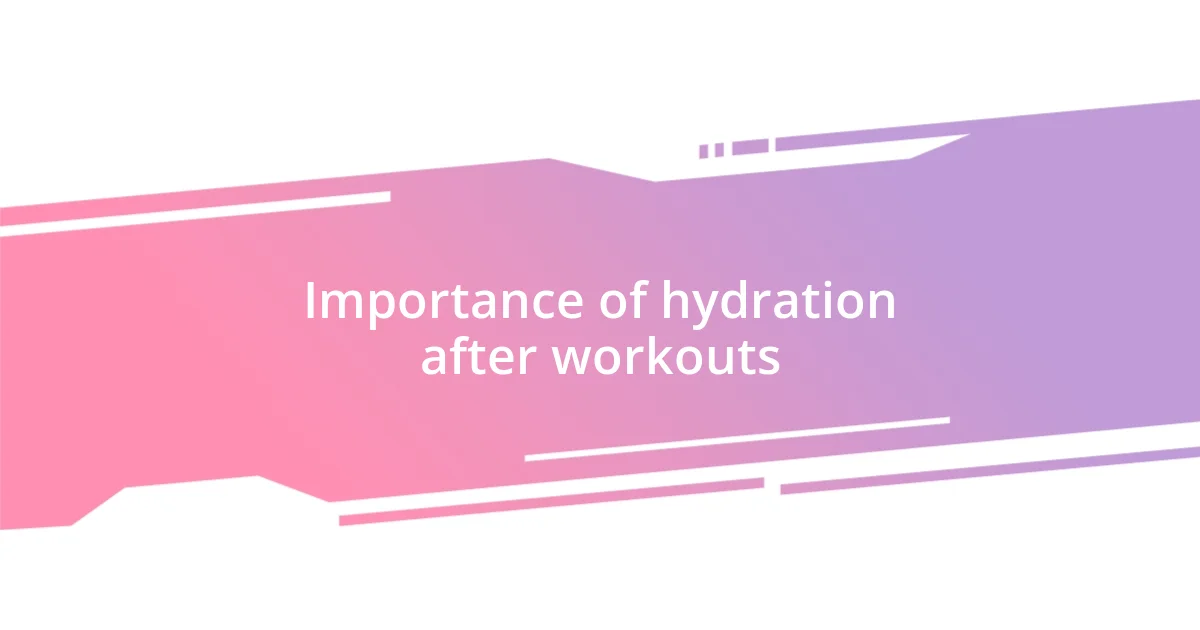Key takeaways:
- Post-workout recovery is critical for performance, with proper nutrition and hydration being essential for muscle repair and energy restoration.
- Incorporating stretching and foam rolling into your routine enhances flexibility, reduces soreness, and aids in healing.
- Tracking progress helps identify patterns, motivates improvement, and facilitates appreciation for personal growth in fitness goals.

Understanding post-workout recovery
Post-workout recovery is a foundational aspect of any fitness routine. After a challenging session, your body is in a state of stress and needs adequate time to heal and rebuild. I remember a time when I overlooked this phase; I thought pushing myself harder was the key to progress. It wasn’t until I experienced persistent fatigue and nagging injuries that I realized the importance of recovery in truly enhancing my performance.
One of the core principles of recovery is proper nutrition. When I started paying attention to my post-workout meals, I noticed a significant improvement in how my body felt the next day. For instance, I made it a habit to refuel with a high-protein shake and some healthy carbs right after my workouts. This isn’t just about feeding my muscles; it’s about providing the right building blocks for recovery. Have you ever felt the difference a good meal can make after a tough workout? It’s astonishing how much energy and motivation can be restored through the right fuel.
Hydration is another crucial component that often gets overlooked. I can’t stress enough how important it is to drink water or replenish electrolytes after sweating buckets. I’ve had days when I forgot to hydrate properly, and the impact on my recovery was immediate—I felt sluggish, and my muscles ached more than usual. It’s surprising how something as simple as hydration can dramatically affect your recovery journey. What strategies do you have in place to ensure you’re fully hydrated?

Importance of hydration after workouts
After a workout, I’ve found that staying hydrated can make all the difference. I recall a time when I had a fantastic gym session but forgot to replace the fluids lost through sweat. The next day, I felt like I’d run a marathon—my body was not only tired but also achy and sore. This experience really opened my eyes to how critical hydration is for recovery and overall performance.
You might be wondering why hydration holds such significance. Here are a few compelling reasons to keep in mind:
- Replenishing fluids: Rehydrating helps to restore the fluids lost during exercise, which is essential for muscle recovery.
- Electrolyte balance: Drinking water or electrolyte drinks can prevent muscle cramps and optimize muscle function.
- Energy restoration: Proper hydration aids in nutrient transport, providing your muscles with the necessary fuel to bounce back stronger.
- Cognitive clarity: Staying hydrated helps improve focus and mental sharpness, allowing for better performance in subsequent workouts or daily activities.
For me, keeping water nearby during workouts has become a non-negotiable habit. I’ve learned that even a small bottle of water can serve as a constant reminder to hydrate—my muscles and mind thank me for it!

Nutrition tips for muscle recovery
After a workout, one of my go-to nutrition tips is to prioritize a protein-rich meal. I typically aim for a combination of protein and carbohydrates within that golden 30-minute window after finishing my workout. For example, I love whipping up a smoothie with protein powder, a banana, and some spinach. This not only helps in muscle recovery but also fuels me for the rest of the day. Ever tried pairing your post-workout meal with a delicious treat? It can turn recovery time into a highlight of your day!
Another essential aspect of muscle recovery is the intake of healthy fats. Omega-3 fatty acids, found in foods like salmon, flaxseeds, and walnuts, work wonders in reducing inflammation and promoting faster healing. When I began incorporating more of these foods into my diet, I noticed a remarkable difference in how quickly my soreness faded. It’s amazing how food can act like the body’s natural medicine. Have you ever noticed how certain meals seem to work magic on your recovery?
Lastly, I can’t stress enough the importance of maintaining balanced nutrition throughout the day, not just post-workout. After workouts, my body craves more than just protein and carbs; I include plenty of colorful fruits and vegetables in my meals. Their vitamins and antioxidants help in fighting off oxidative stress and speeding up the recovery process. One of my favorite go-tos is a mixed fruit salad topped with Greek yogurt, which feels incredibly refreshing and restorative. This simple dish ensures I’m feeding my body a spectrum of nutrients, making me feel vibrant and ready for whatever challenges come next.
| Nutrition Component | Benefits |
|---|---|
| Protein | Repairs muscle damage, promotes muscle growth |
| Carbohydrates | Restores energy levels, replenishes glycogen stores |
| Healthy Fats | Reduces inflammation, supports hormone regulation |
| Fruits & Vegetables | Provides vitamins/antioxidants for recovery, fights oxidative stress |

Stretching techniques for flexibility
When it comes to improving flexibility through stretching, I’ve found that incorporating dynamic stretches before my workouts sets me up for success. For instance, I often do leg swings and arm circles to warm up my muscles. It’s like telling my body, “Hey, we’re about to move—let’s get ready!” This kind of preparation not only improves my range of motion, but it also makes me feel more agile as I dive into my sessions.
After working out, static stretching becomes my best friend. I particularly love sitting down and stretching my hamstrings or holding a deep lunge to open up my hips. There’s something incredibly satisfying about holding a stretch and releasing the tightness from my muscles. It’s as if I’m telling my body, “You’ve put in the work; now let’s ease up and allow for recovery.” Have you ever experienced that blissful moment when you finally reach a stretch that feels just right?
Incorporating both types of stretches has really enhanced my routine. I’ve noticed that not only do I recover faster, but my overall flexibility has improved. I remember when I struggled to touch my toes—now, that’s a cakewalk! It’s these little victories that motivate me to stay consistent. Flexibility isn’t just about the range of motion; it’s about feeling empowered in your body. What stretches do you enjoy that bring you a sense of accomplishment?

Foam rolling benefits for soreness
Foam rolling has become an essential part of my post-workout routine, especially when it comes to managing soreness. I remember the first time I rolled out my sore legs after a tough leg day; the immediate relief was almost euphoric. It’s like giving my muscles a gentle, loving massage that helps alleviate tension and promotes blood flow. Have you felt the difference between tight and relaxed muscles? That contrast is profound, and foam rolling plays a big role in that transition.
One of the most fascinating benefits of foam rolling is its impact on the fascia, the connective tissue surrounding muscles. When I consistently use a foam roller, I notice my range of motion improves, allowing me to move more freely in everyday activities. The sensation of rolling over tight spots, often referred to as “trigger points,” can be intense, but that discomfort usually leads to a greater sense of relief. It’s almost like your body is saying, “Thank you for taking care of me!” What’s your experience with that moment of discomfort turning into relief?
Interestingly, I’ve also found that foam rolling helps reduce the risk of injury. Consistently rolling out my muscles seems to help me recover faster and get back to my workouts feeling fresh. I vividly recall a time when I skipped foam rolling for a week, thinking I was fine. The next workout left me with nagging soreness that lingered far too long. Since then, I’ve made foam rolling a non-negotiable. It’s comforting to know that such a simple tool can have such a powerful impact on my recovery journey. How often do you incorporate foam rolling into your routine?

Tracking progress for better results
Tracking my progress has been a game changer when it comes to achieving better results in my fitness journey. I remember the first time I jotted down my weights and reps in a notebook—it was eye-opening! Seeing those numbers grow over time filled me with a sense of accomplishment and encouraged me to push myself further. Have you ever looked back at your notes and felt that rush of motivation? The ability to visualize my improvements truly added a new layer to my workouts.
I’ve learned that consistency in tracking isn’t just about numbers; it’s also about noticing patterns in how my body responds. For instance, I discovered that my strength peaks after a good night’s sleep and a nutritious breakfast. That insight prompted me to adjust my routine, ensuring I fueled my body properly before hitting the gym. It’s fascinating how the simple act of tracking can provide those little revelations that make a big difference. Do you keep track of factors like sleep or nutrition alongside your workouts?
On the emotional side, there’s something incredibly rewarding about documenting my journey. Revisiting those early days—when I could barely complete a set—reminds me of how far I’ve come. Celebrating those milestones, no matter how small, has cultivated a deeper appreciation for my efforts. I often find myself asking, “What’s next?” That anticipation excites me, pushing me to set new goals. How do you celebrate your own progress along the way?













